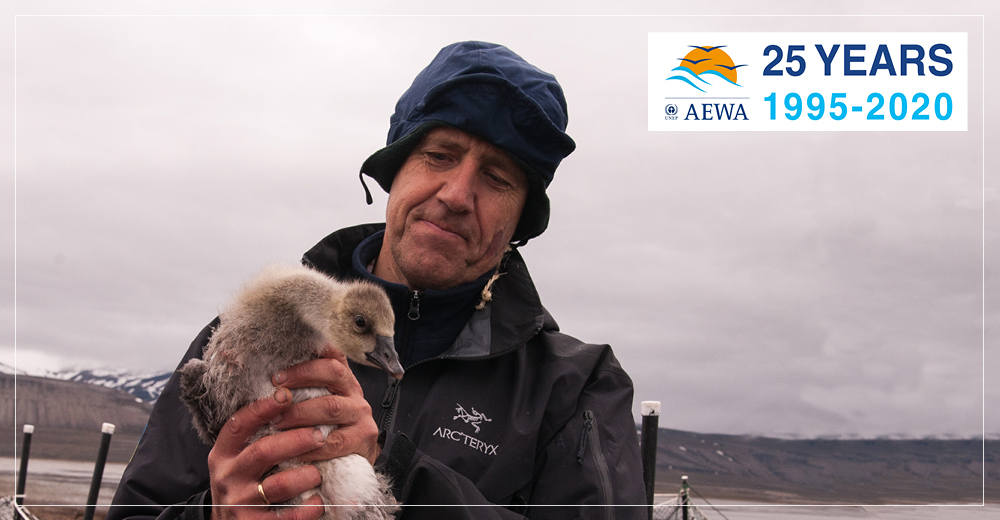25 Years of AEWA – Statement by Øystein Størkersen, Former Chair of the AEWA Standing Committee

25 Years of AEWA – Statement by Øystein Størkersen, Former Chair of the AEWA Standing Committee
AEWA is a favourite of mine among Conventions, simply because it deals with concrete issues, such as species or concrete sites and it gives strong guidance through obligatory requirements. I am also pleased that AEWA is not afraid of difficult issues or of giving advice on how to solve issues. This is not least thanks to the very active and competent AEWA staff. Due to its ability to rapidly adapt to changing issues, AEWA is increasingly becoming a treaty that aims to make a difference. This has been possible not least to a network of professsional experts and national managers.
Birds are super-flagship species! I dare say that no other species group is better known and studied, but also loved by so many as they journey across continents. In a world with increasing industrialization of the landscapes and loss of biodiversity in its wake, birds have to tackle many obstacles and threats. Many more threats to their survival than the average politician or citizen realizes. As a biologist, I see it as both a mystery how birds manage to tackle all these threats during their extremely long travels and then still find places where they can actually feed and shelter. No wonder that we need international cooperation to inform governments and the public to take action to protect birds and their living spaces.
The grim story of indiscriminately killing birds, without consideration of their status and their ecological functions both for the environment and humans is apalling. I believe that AEWA has steadily become a stronger and stronger ray of light and hope for many bird species. AEWA has shown that it can actually work to save birds and their habitat, by using best science and collaboration among countries.
In 2019 the report from IPBES on the status of biodiversity in the world was a turning point for many. This and the important report from the climate panel in 2018 received the attention of politicians and therefore started something new. Both reports show us that industrialization of the wider landscapes is an issue both in the so-called developed and in the developing world. The UN General Assembly has told us repeatedly to change our practices, if we are to conserve functioning ecosystems and the well-being of humans.
We are indeed living in dramatic times, with unprecedented destruction of the environment, increase in zoonotic diseases as a consequence and on top of this also threats from a warming climate. These issues are interlinked and the notion of 'One Nature' has meant that politicians and businesses worldwide for the first time recognize their enormous negative impacts on the environment and therefore future generations. Conservationists have struggled for many decades, such as the publication of Rachel Carson’s book 'Silent Spring' in 1962. Unfortunately, consideration of the well-being of the environment and future generations has for a long time not been strong enough arguments for politicians to alter their behaviour. This is changing now and responsible politicians have grasped what conservationists have been saying for years. I believe that instruments such as AEWA are well placed and our advice can now have more impact.
I ask myself if the many AEWA and CMS resolutions and guidance on topics such as linear constructions, wind turbines, lead and pesticide poisoning, conservation of wetlands, sustainable offtake of wildlife etc. can be much more effectively implemented by the Parties? Are we speaking the right language or should we change our tactics? One of the great challenges around the world is that there is too little international collaboration, and transfer of know-how and funds to countries in need. A challenge we really have to step up on as we need to do much more than we are doing today. Many initiatives for new conservation agreements and broader collaboration between influential agencies such as FAO, WHO, UNDP and others are also necessary. I am also convinced that professional NGOs such as Wetlands International, BirdLife International and its national partners, and many more must now be listened to, and their very efficient actions supported much more by governments.
AEWA could review its work for the last 25 years and possibly undertake a dramatic change of its modus operandi. What have we done so far, and is that the same medicine we should prescribe into the future? How can we maximize the use of our scarce funds? - By producing more resolutions? Personally I have been engaged in many Conventions as chair, and know that the Parties and politicians know what they need to do. Still we continue to spend much time on developing more resolutions. The 2010 and now the 2020 targets to halt or slow down the loss of biodiversity have been a failure and reflect the lack of support amongst politicians and business. Can we hope for a change towards 2030 and beyond? I believe that this time we need to implement factual positive changes under the planned post-2020 biodiversity framework of the CBD and the UN Decade on Restoration (2021-2030). More protection and much more restoration and political recognition of the need to actually support protection work both at home and abroad are required. Right now, we need much rethinking among governments, IGOs, NGOs and Conventions. It simply cannot be 'business as usual' anymore.
Øystein Størkersen
Last updated on 17 June 2020


